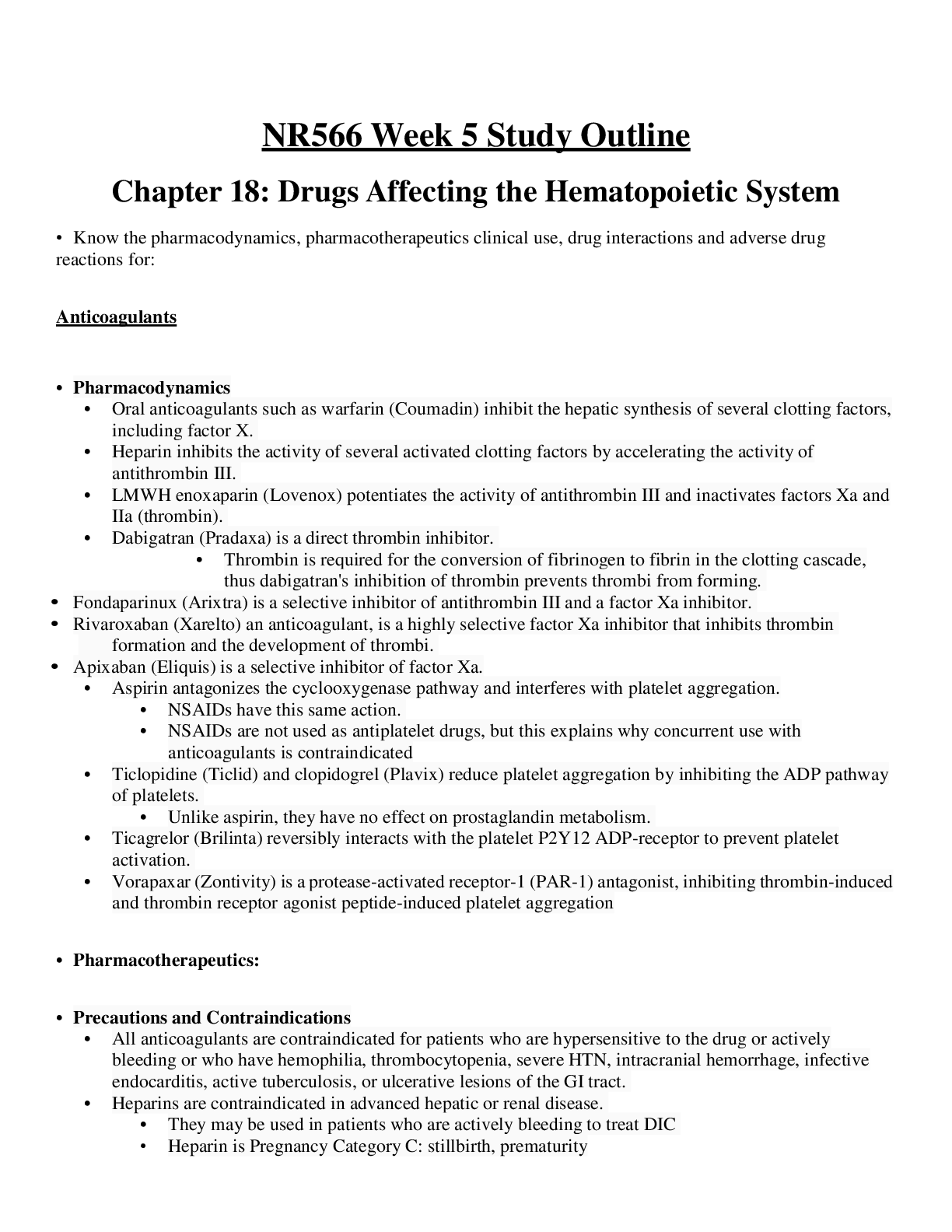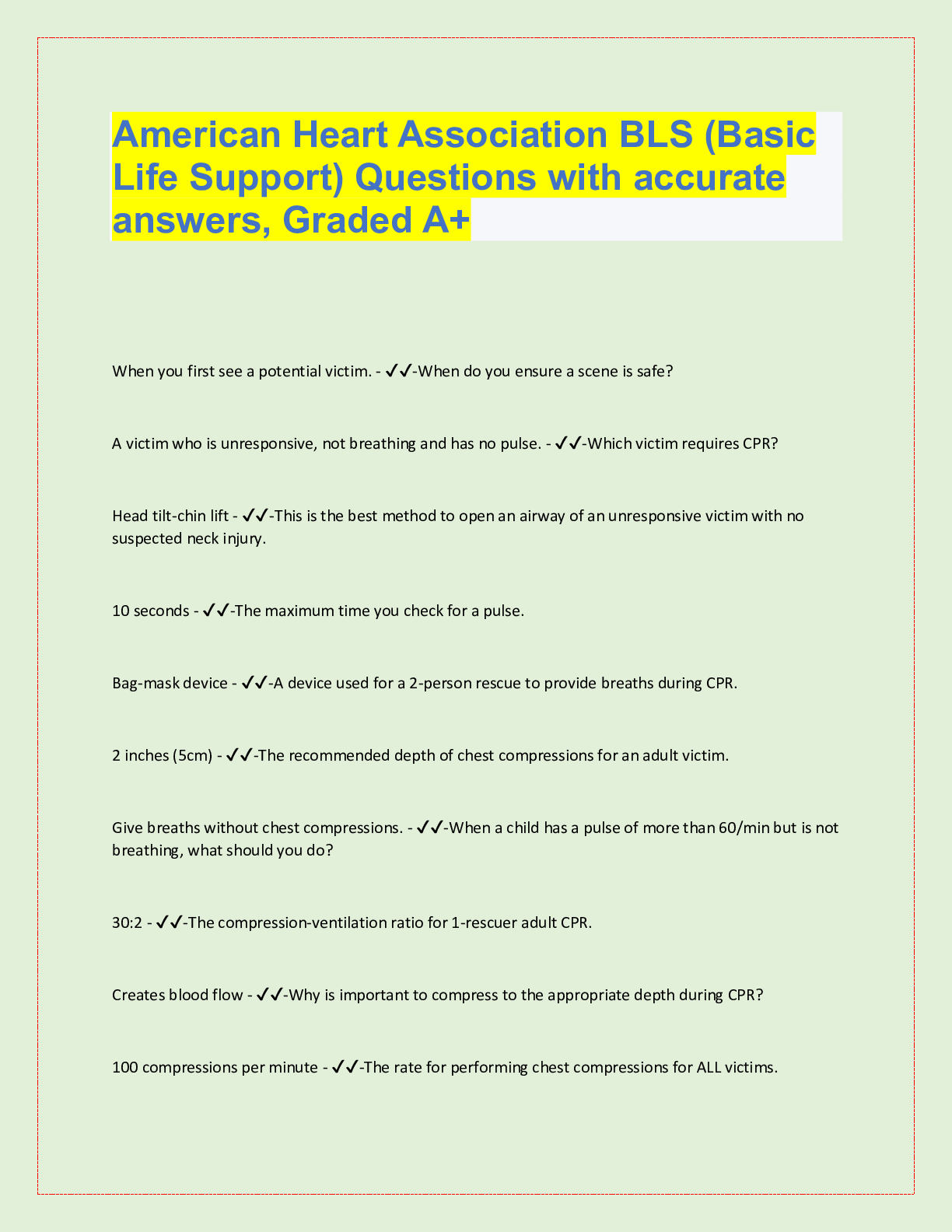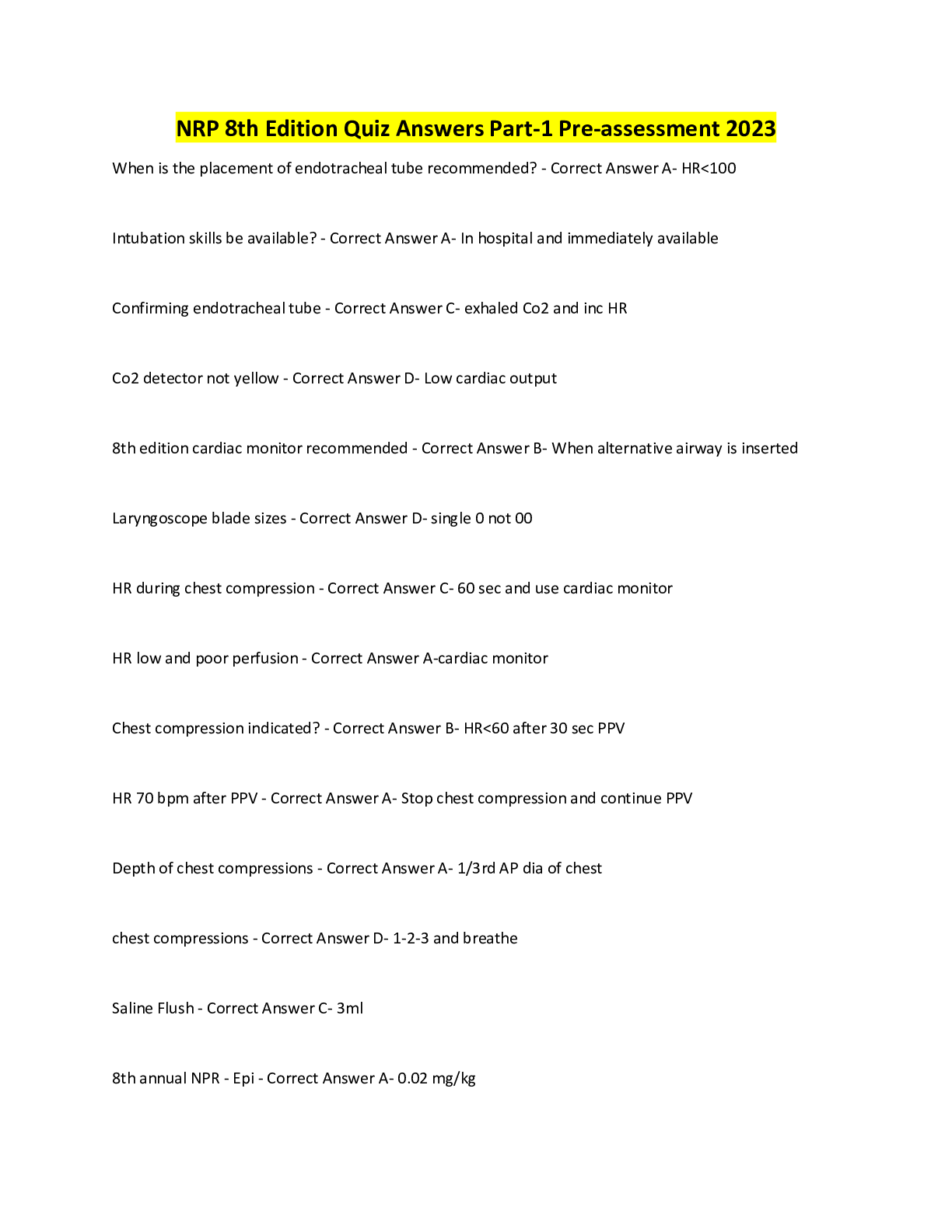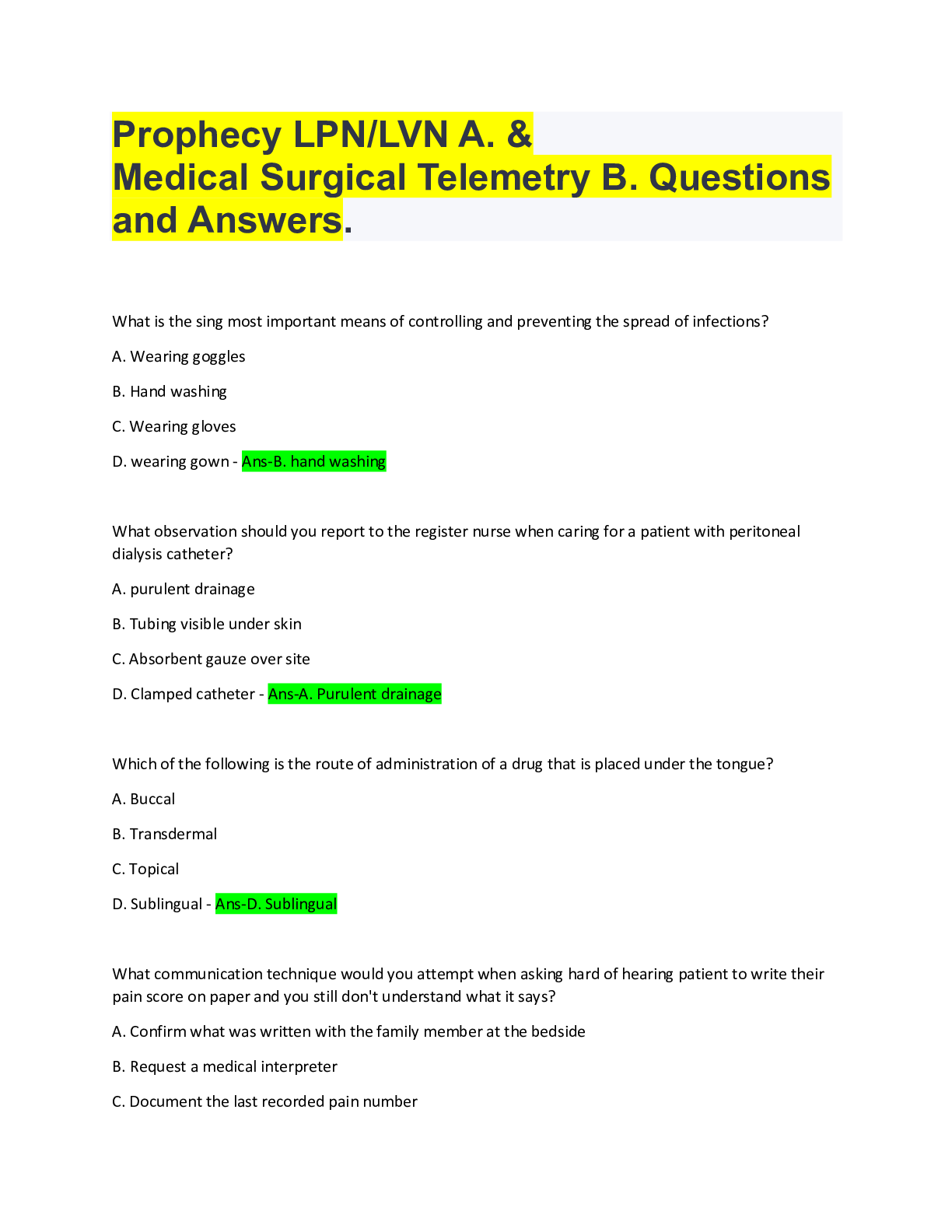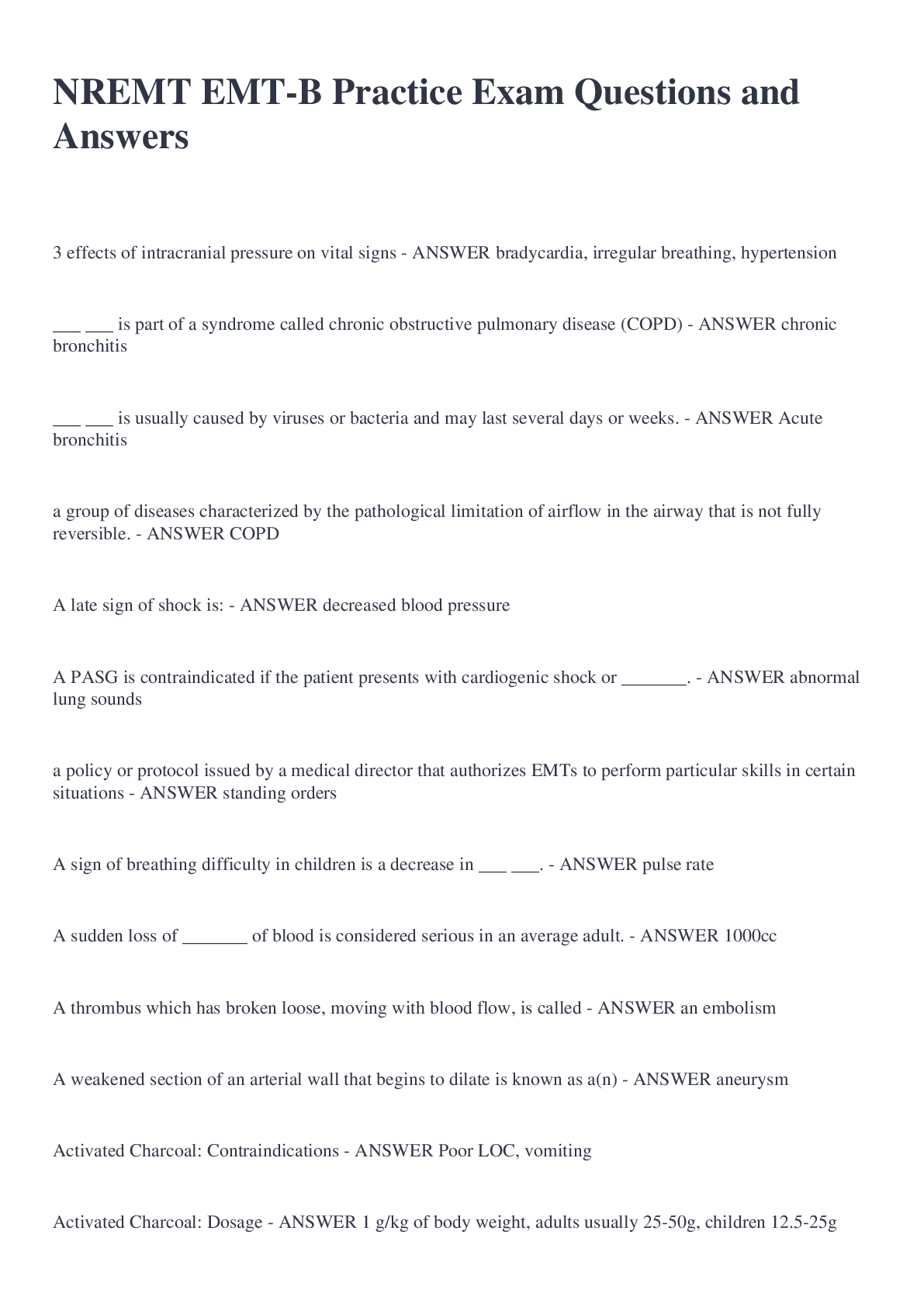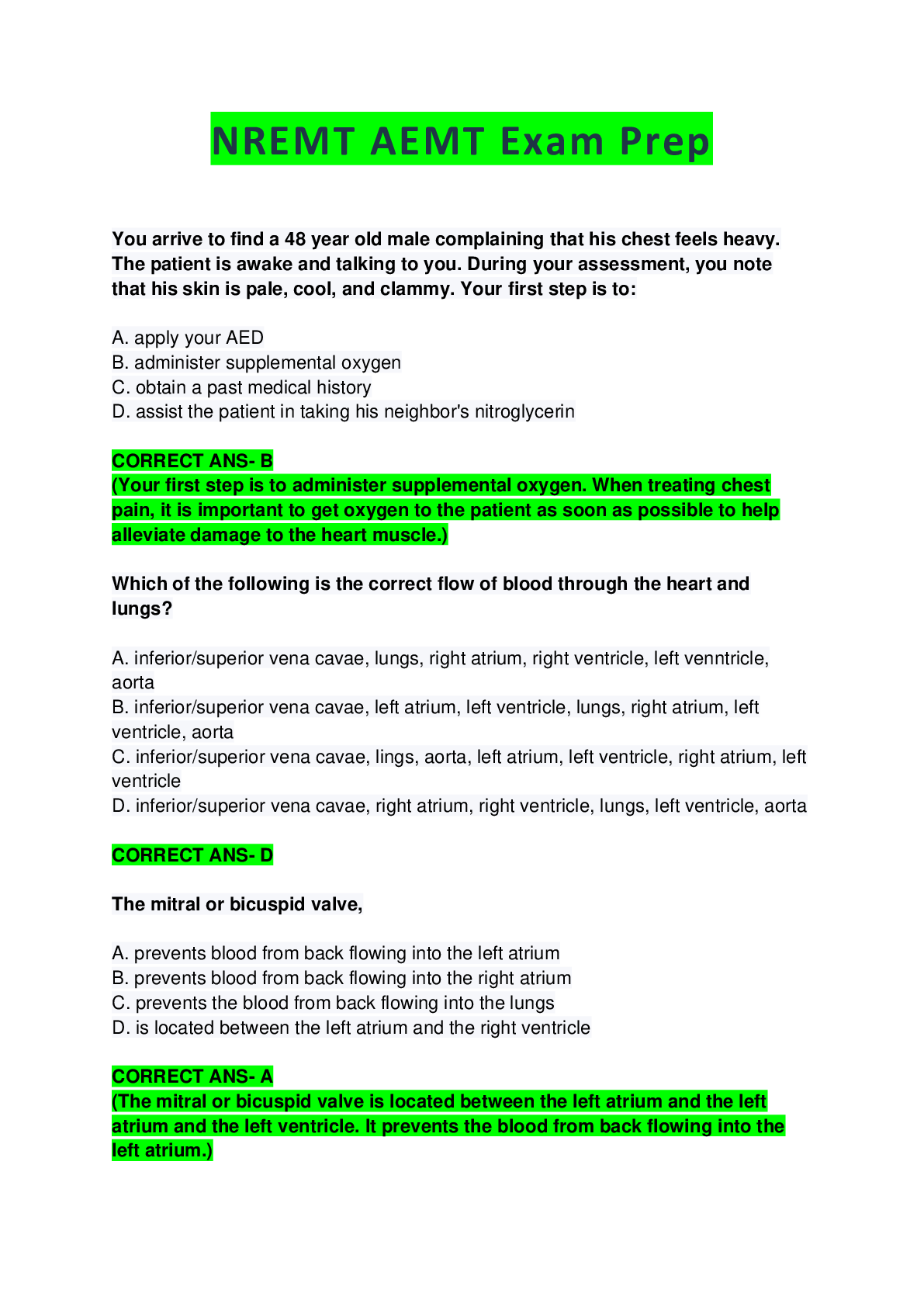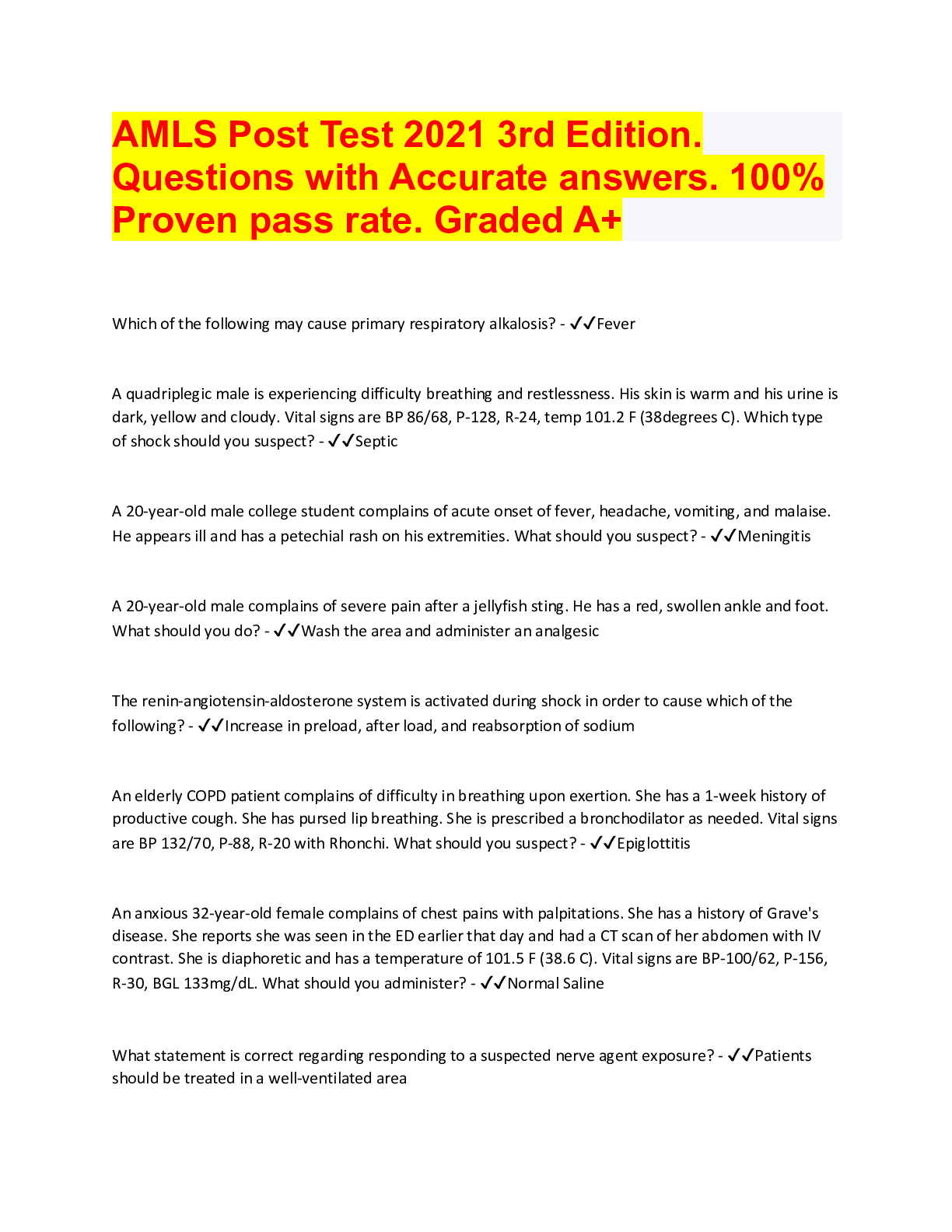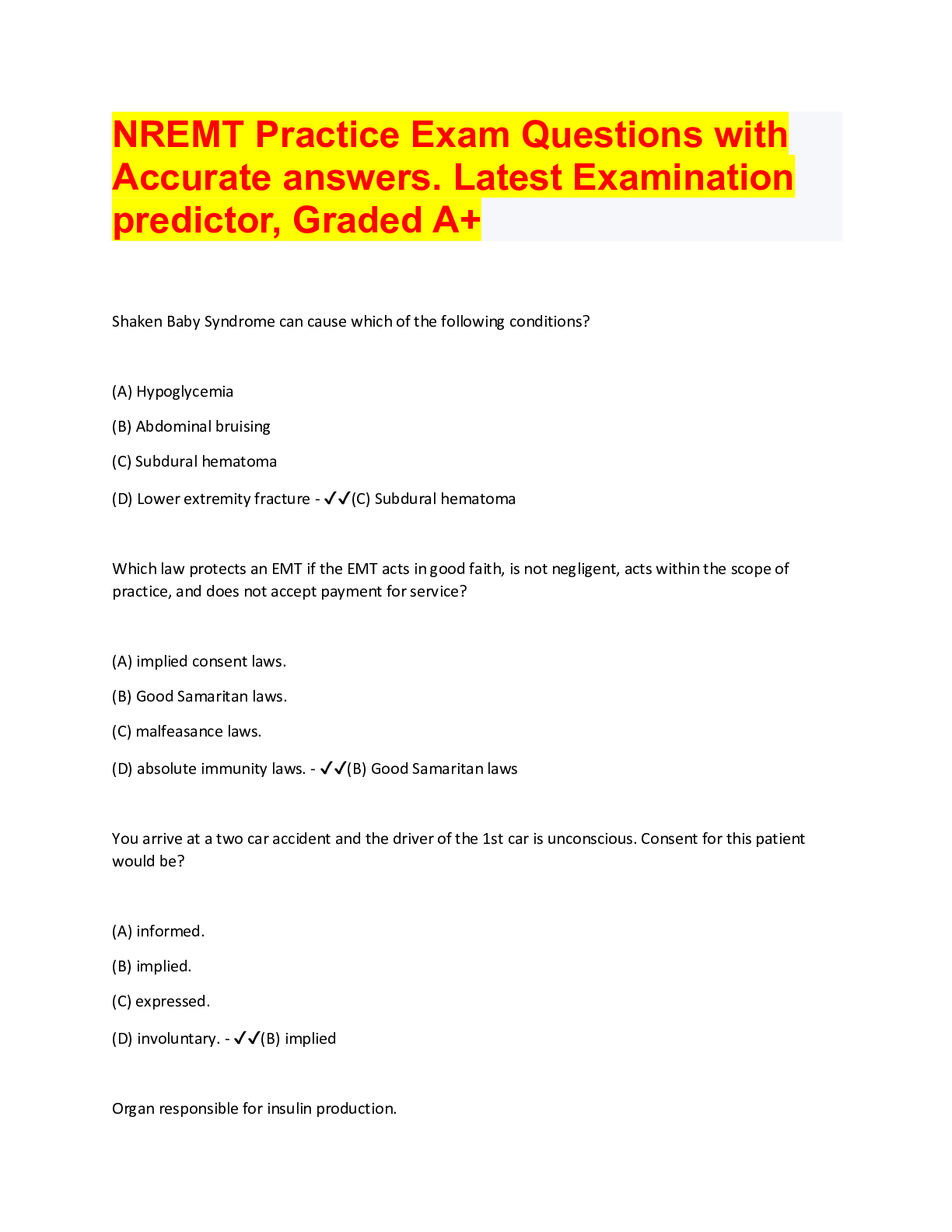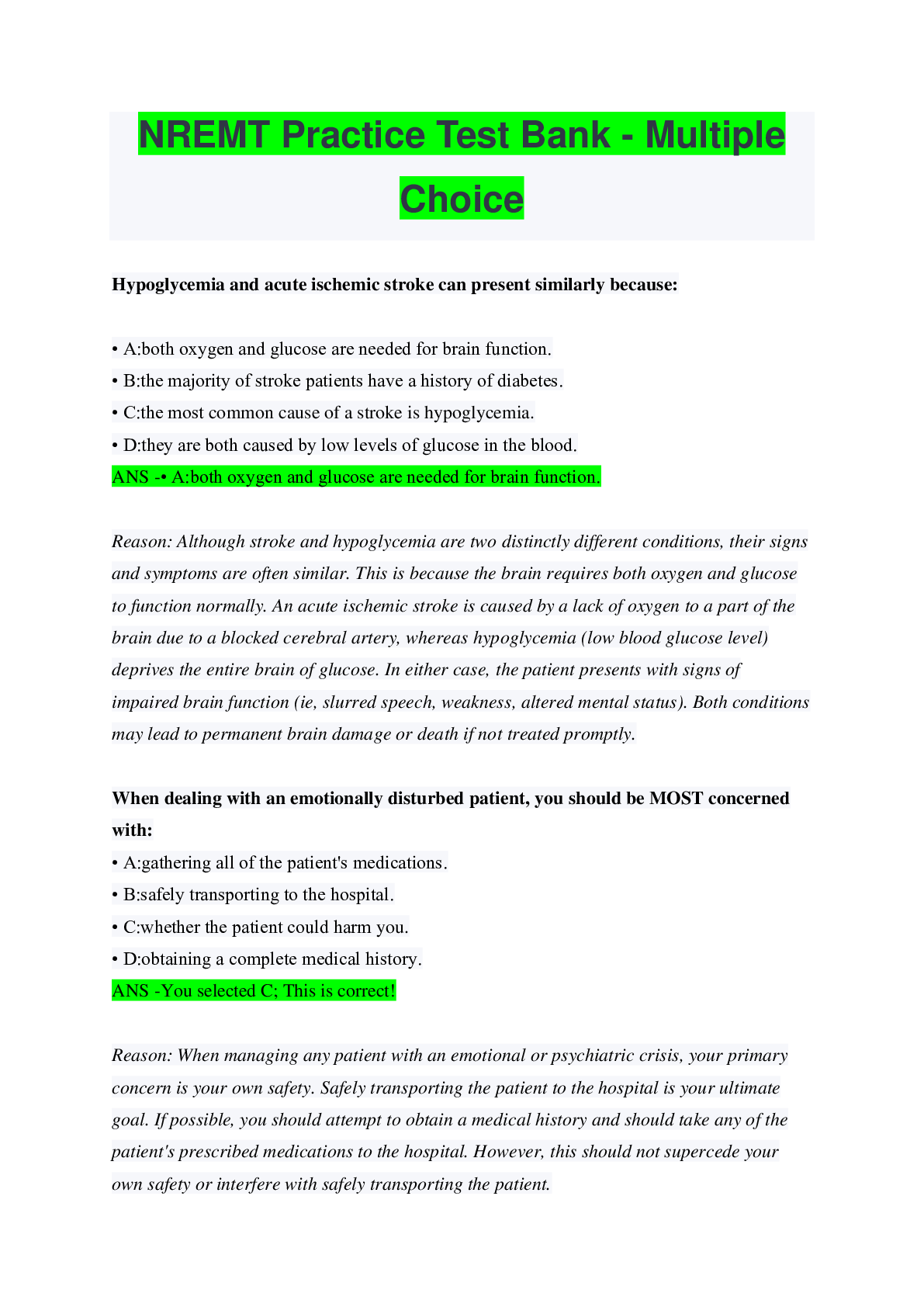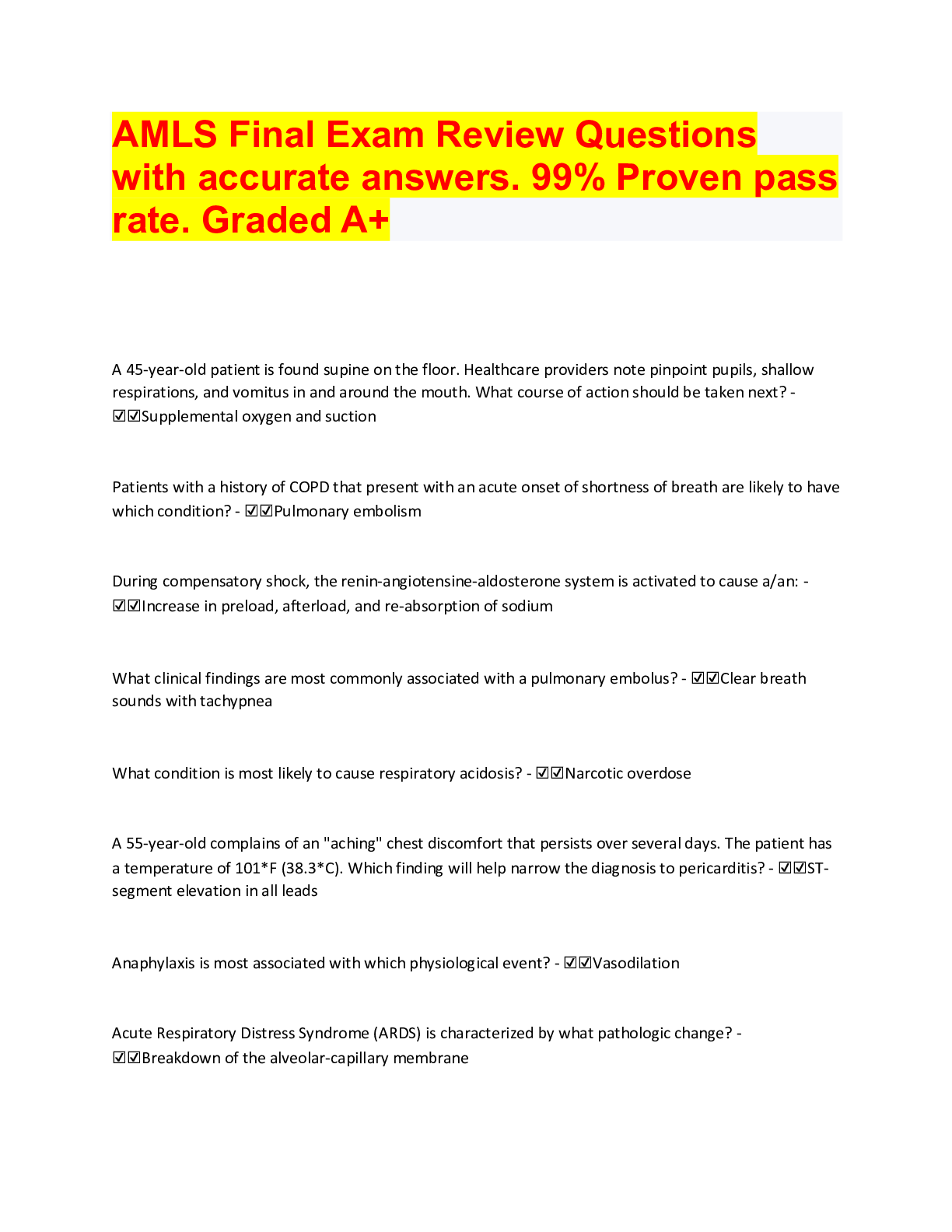*NURSING > QUESTIONS & ANSWERS > NR 566 Final Exam 2021/2022. Questions with accurate answers. 100% approved.. (All)
NR 566 Final Exam 2021/2022. Questions with accurate answers. 100% approved..
Document Content and Description Below
NR 566 Final Exam 2021/2022. Questions with accurate answers. 100% approved.. How to respond to missed doses or changing of contraceptive types from one to another? - ✔✔For products that use ... a 28-day cycle, the following recommendations from the Centers for Disease Control apply: • If one or more pills are missed in the first week, take one pill as soon as possible and then continue with the pack. Use an additional form of contraception for 7 days. • If one or two pills are missed during the second or third week, take one pill as soon as possible and then continue with the active pills in the pack but skip the placebo pills and go straight to a new pack once all the active pills have been taken. • If three or more pills are missed during the second or third week, follow the same instructions given for missing one or two pills but use an additional form of contraception for 7 days. For combination OCs that use an extended or continuous cycle, up to 7 days can be missed? - ✔✔with little or no increased risk for pregnancy provided that the pills had been taken continuously for the prior 3 weeks. If one or more doses is missed or taken greater than 3 hours after the scheduled dose, the following guidelines apply: - ✔✔-If one pill is missed, it should be taken as soon as remembered and backup contraception should be used for at least 2 days. The pills should be resumed as scheduled on the next day. -If two pills are missed, the regimen should be restarted and backup contraception should be used for at least 2 days. -If two or more pills are missed and no menstrual bleeding occurs, a pregnancy test should be done. Types of contraceptives and which would be best for specific patient scenarios - ✔✔Combination OCs should be avoided by women with certain cardiovascular disorders (see later) as well as by women older than 35 years who smoke. For women in these categories, an alternative method (e.g., diaphragm, progestin-only pill, or IUD) is preferable. For women who engage in coitus frequently, OCs or a long-term method (e.g., Nexplanon, Depo-Provera, IUD) are reasonable choices. when sexual activity is limited, and if individual has multiple partners use of a spermicide, condom, or diaphragm may be more appropriate. Because barrier methods combined with spermicides can offer some protection against STDs (as well as providing contraception) If adherence is a problem (as it can be with OCs, condoms, and diaphragms), usterm-16e of a long-term method (e.g., vaginal contraceptive ring, IUD, Nexplanon, Depo-Provera) can confer more reliable protection. What effect does CYP450 inhibitors or inducers have on OCs? o Recall examples of CYP450 inhibitors and inducers from NR565 (Chapter 4 in textbook) o How does this impact prescribing of OCs? - ✔✔Inhibitors: Inducers: Acyclovir Carbamazepine Ciprofloxacin Phenobarbital Ethinyl estradiol Phenytoin Fluvoxamine Primidone Isoniazid Rifampin Norfloxacin Ritonavir Oral contraceptives Tobacco Zafirlukast St. John's wort Zileuton As a rule, high-estrogen OCs are reserved for women taking drugs that induce P450. drugs that interact with oral contraceptives? - ✔✔Products that induce hepatic cytochrome P3A4 can accelerate OC metabolism and thereby reduce OC effects. indications are reduced OC blood levels, such as breakthrough bleeding or spotting. If these signs appear, it may be necessary to either (1) increase the estrogen dosage of the OC, (2) combine the OC with a second form of birth control (e.g., condom), or (3) switch to an alternative form of birth control. can decrease the benefits of warfarin and hypoglycemic agents. May require increased dosage OCs can impair the hepatic metabolism of several agents, including theophylline, tricyclic antidepressants, diazepam, and chlordiazepoxide. Can cause toxicity. if Toxicity occurs dosage may have to be reduced. Prevention of osteoporosis with hormone replacement therapy - ✔✔prevention of osteoporosis requires lifelong HT, and hence the risk for harm is higher. labeling of HT products currently must carry the following advice: When this product is prescribed solely to prevent postmenopausal osteoporosis, approved nonestrogen treatments should be carefully considered. Furthermore, HT should be considered only for women with significant risk for osteoporosis, and only when that risk outweighs the risks of HT. Of course, all women (not to mention men) should practice primary prevention of bone loss by ensuring adequate intake of calcium and vitamin D, performing regular weight-bearing exercise, and avoiding smoking and excessive alcohol use. - When and when not to use progestin for hormone replacement therapy and why - ✔✔Use: -Treatment of moderate to severe vasomotor symptoms associated with menopause • Treatment of genitourinary syndrome of menopause • Prevention of postmenopausal osteoporosis Not use: heart disease dementia alzeheimers disease - Local vs. systemic estrogen options and why one would be chosen over the other - ✔✔Intravaginal: Estrogens for intravaginal administration are available as inserts, creams, and vaginal rings. The intravaginal inserts (Imvexxy, Vagifem, Yuvafem), creams (Estrace Vaginal, Premarin Vaginal), and one of the two available vaginal rings (Estring) are used only for local effects, primarily treatment of vulval and vaginal atrophy associated with menopause. The other vaginal ring (Femring) is used for systemic effects (e.g., control of hot flashes and night sweats) as well as local effects (e.g., treatment of vulval and vaginal atrophy). Parenteral: Although estrogens are formulated for intravenous (IV) and intramuscular (IM) administration, use of these routes is rare. IV administration is generally limited to acute, emergency control of heavy uterine bleeding. - Transdermal estrogen therapy has fewer adverse effects. - ✔✔Compared with oral formulations, the transdermal formulations have four advantages: • The total dose of estrogen is greatly reduced (because the liver is bypassed). • There is less nausea and vomiting. • Blood levels of estrogen fluctuate less. • There is a lower risk for DVT, pulmonary embolism, and stroke. How to change patient from one combination oral contraceptive to another. - ✔✔When one combination OC is being substituted for another, the change is best made at the beginning of a new cycle. o How to initiate treatment (when in the cycle is it best to start- may vary based on type of contraceptive) - ✔✔Most 28-day cycle products are taken in a repeating sequence consisting of 21 days of an active pill followed by 7 days on which either (1) no pill is taken, (2) an inert pill is taken, or (3) an iron-containing pill is taken. The sequence is begun on either the first day of the menstrual cycle or the first Sunday after the onset of menses. With the first option, protection is conferred immediately; hence no backup contraception is needed. With a Sunday start, which is done to have menses occur on weekdays rather than the weekend, protection may not be immediate; hence an alternate form of birth control should be used during the first 7 days of the pill pack. With both options, each dose should be taken at the same time every day (e.g., with a meal or at bedtime). Successive dosing cycles should commence every 28 days even if there is breakthrough bleeding or spotting. o What teaching needs to be done for OC - ✔✔Educate patients on proper protocol for missed doses (depending on medication type and cycle). Effectiveness of oral contraceptives can be reduced with some medications, including certain common antibiotics. o Contraindications for Oral Contraceptives - ✔✔Contraindications to use include current pregnancy, history of thromboembolus, breast cancer, and women over 35 years of age who continue to smoke tobacco. Use with caution in women with diabetes, hypertension, and cardiac disease. [Show More]
Last updated: 1 year ago
Preview 1 out of 16 pages

Reviews( 0 )
Document information
Connected school, study & course
About the document
Uploaded On
Aug 16, 2022
Number of pages
16
Written in
Additional information
This document has been written for:
Uploaded
Aug 16, 2022
Downloads
0
Views
169
